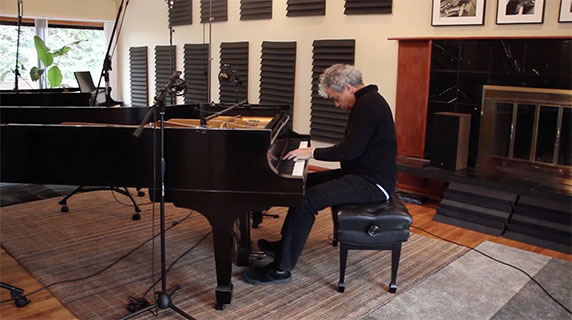
Jon Cleary
Jon Cleary is a British-born American funk and R&B musician based in New Orleans, Louisiana, where he has studied the musical culture and life of New Orleans for 35 years.
Seminar Description
Seminar Description
Incorporating Blues & Funky Riffs into Jazz Standards
Welcome to this lesson on integrating bluesy, funky riffs into jazz standards. In this session, we explore how to infuse blues elements into jazz chord progressions and melodies, adding richness and authenticity to your playing.
Understanding Jazz Standards & Their Structure
Jazz standards have stood the test of time due to their strong melodies and harmonic structures. Typically, a jazz standard features sophisticated chord progressions that provide a foundation for improvisation. The challenge is to maintain the essence of the tune while incorporating blues phrasing, syncopation, and embellishments.
To achieve this, we focus on two key aspects:
- Chord Voicings – Ensuring smooth transitions between harmonies.
- Melody Interpretation – Adding blues inflections and phrasing.
Adding Blues Riffs to Jazz Melodies
Blues elements can be integrated in two main ways:
- Harmonic Approach: Bluesy passing chords can be used to lead from one chord to the next, such as adding chromatic movement before resolving to the target chord.
- Melodic Approach: The use of blues scales, bends, and phrasing techniques to stylize a jazz melody. For example, transitioning from a minor 3rd to a major 3rd (common in blues) within a jazz tune gives it a distinctively soulful sound.
A great example is the way Ray Charles approached "Georgia on My Mind," incorporating blues licks into the melody while respecting the harmonic structure.
Walking Bass & Right-Hand Voicings
A key aspect of playing blues-influenced jazz is mastering the walking bass line in the left hand while comping or playing riffs in the right hand. Here’s how to practice this technique:
- Start with simple octaves in the left hand, ensuring that your fingers maintain a consistent distance.
- Introduce a chromatic approach to walking bass, such as moving stepwise between chord roots.
- Once the bass line is solid, play simple chord stabs in the right hand.
- Gradually incorporate syncopation and passing tones to make the lines groove.
This technique is particularly effective in New Orleans-style blues and boogie-woogie piano.
The Role of Passing Chords in Blues & Jazz
Passing chords add motion and depth to harmonic progressions. In a blues context, passing chords serve to smooth out transitions between primary chords. Some common passing chord techniques include:
- Chromatic Approach: Moving through diminished or dominant chords to connect primary chords.
- Subdominant Minor Chords: Using a minor version of the IV chord before resolving back to the I chord (e.g., Bb-7 before returning to F7 in an F blues).
- Secondary Dominants: Approaching a target chord using its V7 (e.g., playing A7 before resolving to D7).
These techniques help create tension and resolution, enhancing the storytelling aspect of blues-infused jazz.
The "Big 4" & Syncopation in New Orleans Blues
The "Big 4" is a rhythmic concept unique to New Orleans piano and drumming traditions. Instead of emphasizing the downbeat (beat 1), the groove anticipates the fourth beat of the measure, creating a distinctive swing feel.
This concept is deeply tied to marching band rhythms in New Orleans music, where the tuba or bass drum would emphasize the offbeat. It’s also a crucial element in funk and rhythm & blues, influencing players like Dr. John, James Booker, and Professor Longhair.
To develop this feel, practice playing with an anticipated backbeat, shifting accents off the strong beats to create rhythmic tension and drive.
5 Key Practice Tips
- Listen to Blues & New Orleans Piano Masters – Study Ray Charles, Dr. John, and James Booker to hear how they incorporate blues phrasing into jazz.
- Practice Walking Bass Lines – Lock in the left-hand groove before adding right-hand comping or melody.
- Experiment with Passing Chords – Try chromatic approaches, secondary dominants, and diminished passing chords to enhance transitions.
- Master the Blues Scale & Phrasing – Use minor 3rds, slides, and syncopation to add soulfulness to your playing.
- Develop Your Sense of Swing & Groove – Work on syncopation and the "Big 4" feel to capture the rhythmic essence of New Orleans piano.
By incorporating these techniques, you’ll be able to add bluesy color and rhythmic energy to jazz standards, creating a more expressive and dynamic performance. Keep practicing, and enjoy the journey!









Hey everyone,
I am working on adding the light-up keyboard asap.
Cheers,
Hayden
Last 5 minutes cut out audio
Hi Bruce,
This is fixed now and the light-up keyboard has also been added in.
Enjoy the seminar!
Cheers,
Hayden
Terrific Jon, thanks so much. I like both your playing and the historic background you bring to the lessons. Many thanks!